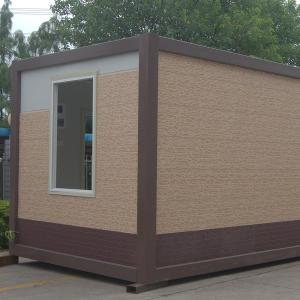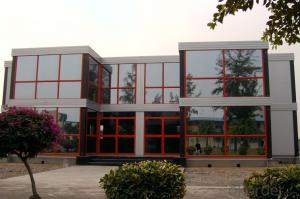Container home 006
- Loading Port:
- Shekou
- Payment Terms:
- TT OR LC
- Min Order Qty:
- -
- Supply Capability:
- 500 set/month
OKorder Service Pledge
OKorder Financial Service
You Might Also Like
Specifications:
Dimensions:
Length: 5,800mm
Width: 2,400mm
Height: 2,620mm
Room area: 13.92m2
Customized requirements are accepted
Materials:
Frame: light steel structure
Wallboard: sandwich panel (alternative insulation material: EPS/rock wool)
Window: PVC frame (alternative: aluminum), sliding, regular or customized
Door: sandwich panel steel (alternative: aluminum), regular or customized
Interior infrastructure:
Basic electricity system
Other optional facilities such as toilet, shower, washbasin and more can be provided depend on customer's requirement
Furniture and appliances of life also can be customized, as well as internal finishing
Applications:
Temporary dormitories/offices/kitchens/toilets for workers inconstruction site, mining camps and other industrial areas
Lifespan: 15 years
Advantages:
Easy and quick to install, construction time saved
Green materials, environment protecting and no garbage
Safe, earthquake-resistant, fireproof and waterproof, nice heat and sound insulation
Assembled and disassembled several times without damage and used repeatedly
Nice appearance and comfortable to live in
Packing:
Flat packing
Quantity: 4 sets/1 bundle with same size as one 40 feet GP container, shipped directly, transportation cost-saving up to 75%
- Q: Are container houses suitable for individuals with allergies or sensitivities?
- Container houses can be suitable for individuals with allergies or sensitivities, as they can be designed to have proper ventilation systems and insulation, which helps to minimize the presence of allergens or irritants. Additionally, container houses can be built with non-toxic materials, reducing the risk of triggering allergic reactions or sensitivities. However, it is important for individuals with specific allergies or sensitivities to consider their specific needs and consult with a professional to ensure the house is tailored to their requirements.
- Q: Are container houses suitable for temporary event spaces or venues?
- Yes, container houses can be suitable for temporary event spaces or venues. Container houses are versatile and can be easily modified to fit the specific needs of an event. They can be transformed into open, airy spaces by removing walls and adding windows or doors. Additionally, containers can be stacked or arranged in different configurations, allowing for a customizable layout that can accommodate different types of events such as exhibitions, pop-up shops, or temporary restaurants. Container houses are also portable, making them convenient for events that require mobility or need to be relocated. Moreover, they are cost-effective compared to traditional event spaces, as containers are readily available, and the construction and setup time are significantly reduced. Overall, container houses offer a unique and innovative solution for temporary event spaces or venues, providing a modern and sustainable alternative to traditional structures.
- Q: Can container houses be designed with a modern bathroom?
- Yes, container houses can definitely be designed with modern bathrooms. With proper planning and design, container houses can be equipped with all the necessary features of a modern bathroom, including fixtures, plumbing, and stylish designs. The compact nature of container houses may require some creativity and space optimization, but it is certainly possible to incorporate modern amenities and aesthetics into the bathroom design of a container house.
- Q: How do container houses compare to traditional houses in terms of resale value?
- Container houses typically have lower resale value compared to traditional houses. This is mainly due to the unconventional nature of container houses, which may limit their appeal to a narrower market of buyers. Traditional houses, on the other hand, tend to have more widespread demand and offer a wider range of features, amenities, and design options. While container houses can be cost-effective and eco-friendly alternatives, they may face challenges in terms of perceived value and market acceptance when it comes to reselling.
- Q: Can container houses be designed with a kitchenette?
- Indeed, it is possible to incorporate a kitchenette into container houses. Despite their smaller size when compared to conventional houses, container houses can still accommodate a fully functional kitchenette. The design may encompass a compact cooking area equipped with a stove or cooktop, a sink, ample countertop space for meal preparation, and storage for kitchen essentials. The kitchenette can be tailored to the specific requirements and desires of the occupants, thereby rendering it a practical and convenient attribute of a container house.
- Q: Are container houses suitable for music or recording studios?
- Yes, container houses can be suitable for music or recording studios. Container houses offer a wide range of benefits that make them a viable option for creating a music or recording studio. Firstly, container houses are highly customizable. The interior layout can be modified to suit the specific needs of a music or recording studio. Soundproofing is a crucial aspect for these types of spaces, and container houses can be designed to have excellent sound insulation. Specialized materials can be used to ensure that sound does not escape the studio and that external noise does not infiltrate the recording area. Additionally, container houses are cost-effective. They are generally cheaper to build or convert into a music studio compared to traditional construction methods. This affordability can be a significant advantage, especially for independent musicians or small recording studios with limited budgets. Container houses are also portable and flexible. They can be easily transported to different locations if needed, allowing musicians or recording studios to have a mobile setup. This flexibility is particularly beneficial for those who frequently need to change their environment or move to different recording spaces. Furthermore, container houses are environmentally friendly. Repurposing shipping containers reduces the demand for new construction materials and minimizes waste. This eco-friendly approach aligns well with the values of many musicians and recording studios. However, it is important to note that container houses may have certain limitations that need to be addressed when creating a music or recording studio. These limitations include the small size of a single container, which may require multiple containers to be connected for a larger studio space. Adequate ventilation, temperature control, and electrical supply should also be considered during the design process. In summary, container houses can be suitable for music or recording studios due to their customizability, cost-effectiveness, portability, and eco-friendliness. While there may be some limitations, these can be overcome with proper planning and design. Ultimately, container houses offer a unique and innovative solution for musicians and recording studios seeking a creative and functional space.
- Q: Are container houses pet-friendly?
- Yes, container houses can be pet-friendly. With proper planning and design, container houses can offer suitable living spaces for pets. Adequate ventilation, space optimization, and the inclusion of pet-friendly features like designated sleeping areas and access to outdoor spaces can ensure the comfort and well-being of pets in container houses.
- Q: Can container houses be moved easily?
- Yes, container houses can be moved easily. One of the advantages of using shipping containers as building materials is their portability. They are designed to be transported by ships, trucks, and trains, which means they can be easily moved from one location to another. Additionally, container houses are built to withstand harsh weather conditions during transportation, making them a reliable option for those who want a flexible and transportable housing solution.
- Q: What are the different sizes of container houses available?
- To accommodate different needs and preferences, container houses are available in various sizes. The standard lengths used in shipping are 20-foot and 40-foot containers. A 20-foot container house typically provides approximately 160 square feet of living space, while a 40-foot container house offers around 320 square feet. However, these sizes can be altered and combined to create larger spaces. For example, some container houses are constructed by joining two 20-foot containers together, effectively doubling the living area to 320 square feet. Additionally, multiple containers can be stacked or connected to create multi-level or more spacious homes. Furthermore, container houses can be personalized by adding features such as decks, balconies, and extensions, which further expand the available living space. These modifications allow for flexibility in design and allow individuals to customize their container houses according to their specific requirements. It's important to note that although the aforementioned sizes are commonly used, container houses can also be built using smaller or larger containers depending on the desired outcome. The size of a container house ultimately depends on factors such as budget, purpose, and the number of occupants.
- Q: Are container houses safe during earthquakes?
- Container houses can be safe during earthquakes if they are properly designed and built to withstand seismic forces. The safety of container houses during earthquakes depends on various factors such as the structural integrity of the containers, the foundation they are placed on, and the overall construction techniques used. Container houses can be reinforced to make them more resistant to earthquakes. Additional steel reinforcements can be added to the containers' corners and walls to increase their structural strength. These reinforcements help distribute the seismic forces evenly throughout the structure, reducing the risk of collapse during an earthquake. Moreover, the foundation on which the container house is placed plays a crucial role in its earthquake safety. A strong and properly designed foundation can help absorb and dissipate seismic energy, minimizing the impact on the structure. It is essential to ensure the container house is securely anchored to the foundation to prevent it from sliding or toppling over during an earthquake. Additionally, the construction techniques used in building container houses should comply with local building codes and regulations. Adequate insulation, fireproofing, and proper electrical and plumbing installations are also essential for the safety and functionality of the house. It is important to note that no structure can be completely immune to the destructive forces of a severe earthquake. However, with proper design, construction, and adherence to safety standards, container houses can provide a safe and durable living space during seismic events. Consulting with structural engineers and following local guidelines can help ensure the safety of container houses in earthquake-prone areas.
Send your message to us
Container home 006
- Loading Port:
- Shekou
- Payment Terms:
- TT OR LC
- Min Order Qty:
- -
- Supply Capability:
- 500 set/month
OKorder Service Pledge
OKorder Financial Service
Similar products
Hot products
Hot Searches
Related keywords





























